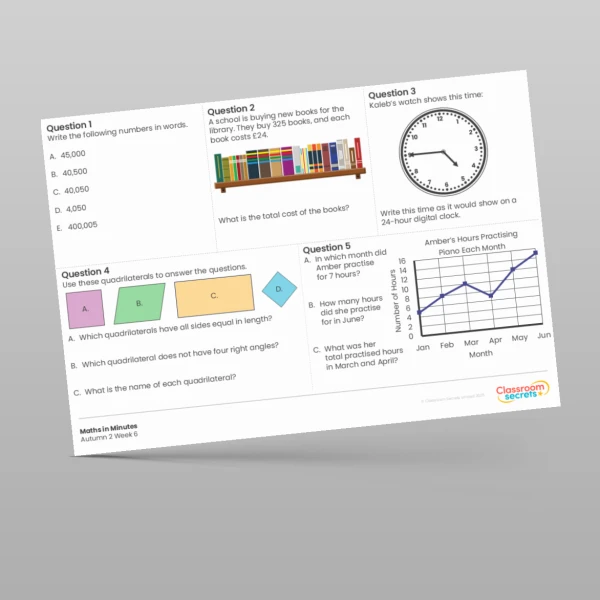

This Year 5 Maths in Minutes resource is designed to promote quick recall and retrieval of children's knowledge and prior learning, recapping a number of objectives from Years 4 and 5 such as converting between digital and analogue times, describing a translation and identifying prime or composite numbers.
There are three sets of five questions that cover a variety of maths skills in the areas of number, calculation, measure, geometry, statistics and position & direction. This activity is perfect to use during registration, at the start of a maths lesson or whenever you have some time to spare. We've specially designed this resource to be displayed on the interactive whiteboard to save on printing costs. Try it today!
Curriculum Objectives
- Compare different measures, including money in pounds and pence
- Read, write and convert time between analogue and digital 24-hour clocks
- Find the area of rectilinear shapes by counting squares
- Compare and classify geometric shapes, including quadrilaterals and triangles, based on their properties and sizes
- Complete a simple symmetric figure with respect to a specific line of symmetry
- Describe movements between positions as translations of a given unit to the left/right and up/down
- Interpret and present discrete and continuous data using appropriate graphical methods, including bar charts and time graphs
- Solve comparison, sum and difference problems using information presented in bar charts, pictograms, tables and other graphs
- Count forwards or backwards in steps of powers of 10 for any given number up to 1,000,000
- Read, write, order and compare numbers to at least 1,000,000
- Round any number up to 1,000,000 to the nearest 10, 100, 1,000, 10,000 and 100,000
- Use rounding to check answers to calculations and determine, in the context of a problem, levels of accuracy
- Establish whether a number up to 100 is prime and recall prime numbers up to 19
- Multiply numbers up to 4 digits by a one- or two-digit number using a formal written method, including long multiplication for two-digit numbers
- Solve problems involving addition, subtraction, multiplication and division and a combination of these, including understanding the meaning of the equals sign
Tags
Autumn
4M1
4M4b
4M7b
4G2a
4G2c
4P2
4S1
4S2
5N1
5N2
5N4
5C3
5C5c
5C7a
5C8b
Maths in Minutes











